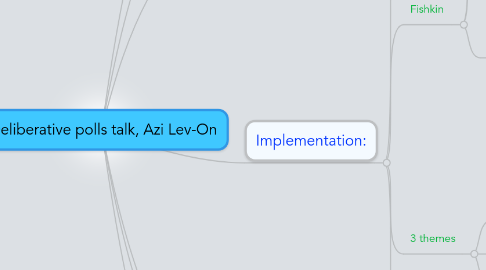
1. Unlike Internet examples such as
1.1. Etsy Town hall meetings
1.2. Second Life meetings
1.3. &c
2. deliberative democracy
2.1. definition in Gutman & Thompson, p7
2.1.1. goverment form in which free citizens or their representatives deliberate on options for decisions which are binding
2.2. why
2.2.1. instrumerntal
2.2.2. legitimizes
2.2.3. encourage different perspectives aimed at common good
2.2.4. community
2.2.5. personal empowerment
3. distinctions
3.1. Deliberation vs. Aggregation
3.2. Deliberation vs. Discourse
3.3. Deliberation vs. Participation
4. Implementation:
4.1. representative or participatory
4.1.1. sample representing the population
4.1.2. or all inclusive
4.2. Fishkin
4.2.1. Fishkin & Luskin, 1999
4.2.2. <see flyer>
4.2.3. process
4.2.3.1. choose sample of the population
4.2.3.2. contact them
4.2.3.3. send materials presenting
4.2.3.3.1. questions/decisions
4.2.3.3.2. arguments pro/con each
4.2.3.4. event day
4.2.3.4.1. opening talk
4.2.3.4.2. different groupd, with moderators
4.2.3.4.3. lunch
4.2.3.4.4. groups discuss
4.2.3.4.5. groups present summaries
4.2.3.4.6. voting
4.3. 3 themes
4.3.1. participation
4.3.1.1. sample of full population taking part in decision making
4.3.2. experts
4.3.2.1. injecting knowledge & ideas
4.3.3. deliberation
4.4. findings
4.4.1. Significant changes in
4.4.1.1. knowledge
4.4.1.2. sophistication
4.4.1.3. consolidation of solutions
4.4.2. examples
4.4.2.1. US
4.4.2.2. EU
4.4.2.3. China
4.4.2.3.1. standard tool for perfecture level decision making
4.4.2.4. Hungary & Bulgary
4.4.2.4.1. Decision regarding Roma (Gypsies)
4.4.2.5. Australia
4.4.3. see
4.4.3.1. http://cdd.stanford.edu/
5. Israel
5.1. During the summer there will be an experiment in Israel
6. Online deliberation polls
6.1. Were tested in the US since 9 years ago
7. Q&A
7.1. taking representative sample of the population helps
7.1.1. address the problem of scale
7.1.2. ensuring heterogenic & representative groups
7.2. goal
7.2.1. improve decision making
